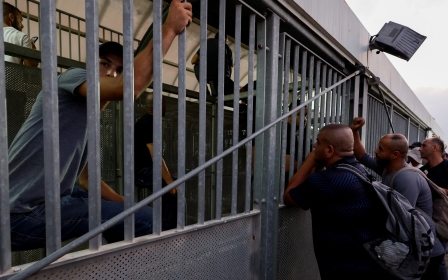Israel: What is behind opening Ramon airport to Palestinian travellers?

As thousands of Palestinian travellers were crammed at the King Hussein Bridge in the sweltering heat on their return home through Jordan, the Israel Hayom news site published a story on 21 July that spread quickly among Palestinian travellers.
All that is being offered to the Palestinians are nominal 'gifts' that would further bind them to Israeli restrictions and move them further away from self-determination
It reported that Israel would allow Palestinians in the West Bank to fly to Turkey through Ramon airport, located in the furthest south of the Negev, which had been closed for two years.
The idea was first raised during a meeting between Israeli Defence Minister Benny Gantz and Palestinian President Mahmoud Abbas on 7 July.
Gantz had presented it as part of a package of "improvements" in exchange for the Palestinian Authority (PA) halting lawsuits against Israel for war crimes at the International Criminal Court (ICC).
On the eve of US President Joe Biden's visit to the region, news coverage of the proposal intensified framing it as being part of the “reform” package that Biden would present to the Palestinians.
New MEE newsletter: Jerusalem Dispatch
Sign up to get the latest insights and analysis on Israel-Palestine, alongside Turkey Unpacked and other MEE newsletters
A 'favour'
Israel is killing two birds with one stone when it presents travel through Ramon as an "easing of restrictions" and a "favour" to the Palestinians who suffer greatly travelling through land bridges with Jordan, while blackmailing them and exploiting their need to travel to save its lifeless and faltering airport after it pumped millions of shekels into it.
This is part of Israel’s recent policy to control the Palestinians and suppress their resistance by providing so-called "economic reforms", such as issuing more work permits and opening some checkpoints.
Likewise, these “reforms”, and the manner through which they are announced in Israeli media, indicate the nature of Israel's relationship with the PA. Israel persistently tries to dispense with the PA as a mediator between it and its Palestinian residents by directly managing people's livelihoods, including with things like the "door to door" project, the al-Munasseq (COGAT) app, and openings in the apartheid wall.
Ramon airport was named after Ilan Ramon, the first Israeli astronaut and a former fighter pilot, who was killed along with six other astronauts after the explosion of the American space shuttle Columbia in 2003 as soon as it entered the atmosphere. Perhaps in an astonishing paradox, the shuttle exploded in the sky over the town of Palestine, Texas in the US.
Ramon airport, which extends over an area of 14,000 acres, is located on the outskirts of Route 901, 18km north of the ethnically cleansed Palestinian village of Umm al-Rashrash, known today as Eilat. A few kilometres to the east lies Wadi Araba and the Jordanian-Palestinian border, and a few kilometres to the west lies Wadi al-Manea.
First civilian airport
According to the official website of the Israeli Aviation Authority, the idea of the airport began around 2004, and it passed through a series of government procedures.
Ramon airport was planned as the second international airport in Israel after Ben Gurion Airport
This included some delays, suspensions as well as construction difficulties due to extreme heat, transportation costs, and the difficulty of attracting workers to a desert area. It was inaugurated in January 2019 after two postponements, at an estimated cost of 1.7bn shekels (about $460m).
This would make it the first civilian Israeli airport to be built after Israel's establishment, as the rest of the civilian airports were inherited from the legacy of British colonialism. Hoping to attract more tourism, Israel sought to develop facilities in the midst of a tourist area that attracts hundreds of thousands of visitors annually, consisting of a triad: Aqaba, Eilat, and Sharm El Sheikh.
Prior to the airport’s construction, tourists flew to Eilat in one of two ways: via international flights that landed at the Ovda Airport, a military airbase which is some 65km from Eilat, or via domestic flights to Eilat Airport from other Israeli airports. However, neither airport was suitable to expand international tourism.
The first is a military airport, a one-hour drive from Eilat, and the second is a relatively small airport located in the heart of a residential suburb that is able to receive limited types of small and medium aircraft.
Ramon Airport was, therefore, planned as the second international airport in Israel after Ben Gurion Airport.
According to the Israeli Ministry of Transportation, Ramon airport was built to be 100 times larger than Eilat airport in order to accommodate international flights carrying foreign tourists to Eilat. Eilat airport was closed as soon as Ramon airport was opened.
Failed expectations
For Israel, the security motive behind opening the airport is inseparable from its economic and tourism ambitions.
This became more evident during Israel’s 2014 assault on Gaza when Palestinian resistance groups forced the suspension of flights to Ben Gurion Airport after a rocket landed about a mile away from it. Dozens of international airlines cancelled their flights to Tel Aviv.
Israel was forced to divert international flights to Ovda Airport. But the chaos and overcrowding that ensued led the government to decide that the small airport would not be a suitable alternative in emergency situations.
The Israeli minister of transport ordered the extension of the landing path at Ramon airport while it was still under construction from 3,100m to 3,600m, allowing the landing of larger aircraft and using it as an approved alternative civilian airport during emergencies.
This offered a solution to Israel’s population and economic centres of gravity in Gush Dan that were within the range of the resistance's rockets. But it did not enjoy this security for long. During Israel’s May 2021 Gaza war, Hamas announced its new "Ayyash" rocket which has a range of 250km, allowing it to reach Ramon airport.
In May 2022, TheMarker, an Israeli business newspaper, published a lengthy article on the Ramon airport, whose shops hardly anyone ever frequents, and has never known the meaning of overcrowding.
The concerns about the airport were summarised in the article’s title: “20 passengers on nine international flights: Why is Ramon airport not rising?” and it goes on to examine the first quarter reported figures of the year.
When Ramon airport opened in 2019, it was said that in the first phase, the airport was expected to receive 1.5 million passengers annually on domestic flights, and 350,000 passengers on international flights, with an expected increase in the frequency of flights to receive 4.25 million passengers.
The airport's first year of operation passed with passenger numbers very close to expectations, but the closures imposed by the Covid-19 pandemic reduced the numbers to far less than that in 2020 and 2021.
But the faltering hopes around the airport are not the result of the pandemic alone.
Despite the promising numbers in the airport’s first year of life, several Israeli bodies in the tourism sector, in particular, predicted the possibility of it failing due to the level of tourist services provided in Eilat, which are considered lower quality and more expensive than what a tourist would get in Aqaba or Sharm El Sheikh.
In addition, Eilat’s tourism is usually low except during the autumn and winter seasons. And to make those seasons more attractive, since 2015, the Israeli Ministry of Tourism has been encouraging international airlines to land in Eilat by paying them 60 euros for each passenger they take there.
This is the reality that the tourism industry in Eilat had long faced and Ramon airport did not succeed in changing it. In an early show of no confidence, about four months after the airport opened to international flights, TheMarker published an article entitled: "We counted the birds: Ramon Airport does not fly", referencing the low number of international flights over the summer.
Buying obedience
In this so-called “easing of restrictions” on Palestinian travellers, Israel seeks to buy the obedience of the Palestinians in exchange for reducing the severe and inhumane restrictions on their movement, livelihood, and access, such as increasing the number of work permits, approving thousands of family unification requests, and opening checkpoints.
But this policy does not mean much. Over the past 20 years, the tools of economic “peace” have been recycled hundreds of times, yet the people continue to struggle for freedom.
The containment policy, presented as though they are facilitating measures, has become the exclusive aim for the talks - which are no longer political - between Israel and the PA.
All that is being offered to the Palestinians are nominal “gifts” that would further bind them to Israeli restrictions and move them further away from self-determination. Many of these "facilitations" offered to the Palestinians are announced in a way that completely supersedes the existence of the PA, which has been stripped of any political meaning. Israel’s various economic "reforms" have reached the peak of humiliation and control, without the PA bothering to go to the trouble of exposing it.
The Ramon airport lies in the hottest area in Palestine, and one that is too remote for residents of the West Bank
The idea of allowing the Palestinians to travel through Ramon airport is not simply a matter of easing restrictions that are meant to control them. It is about extorting the Palestinians through one of their most basic human rights, that is, to travel, in order to save a struggling Israeli airport.
On the other hand, the most the PA did was to issue a statement by the deputy minister of transport and communications, in which he rejected the proposal as "one-sided and reinforc[ing] the policy of apartheid," and called for the restoration of the Jerusalem Airport in Qalandia, allowing for a second airport in Jericho, and the restoration of the Gaza Airport.
Another news piece refers to the PA’s rejection of the project because of political considerations, including protecting its relations with Jordan. The Ramon airport lies in the hottest area in Palestine, and one that is too remote for residents of the West Bank.
The West Bank city closest to the airport is about 250km away, a three-hour drive without factoring in roadblocks, and later upon arrival, the security checks, waiting times, and the humiliation that it accompanies.
The "easy travel experience" that Israel is trying to promote to Palestinian travellers will be, like everything else, conditioned on their “clean” security record, and heavy sweating, in order to save the airport of those who have reached the "end of the world" on the ruins of our blood.
The views expressed in this article belong to the author and do not necessarily reflect the editorial policy of Middle East Eye.
This article was first published in Arabic on the Metras website.
This article is available in French on Middle East Eye French edition.
Middle East Eye delivers independent and unrivalled coverage and analysis of the Middle East, North Africa and beyond. To learn more about republishing this content and the associated fees, please fill out this form. More about MEE can be found here.






